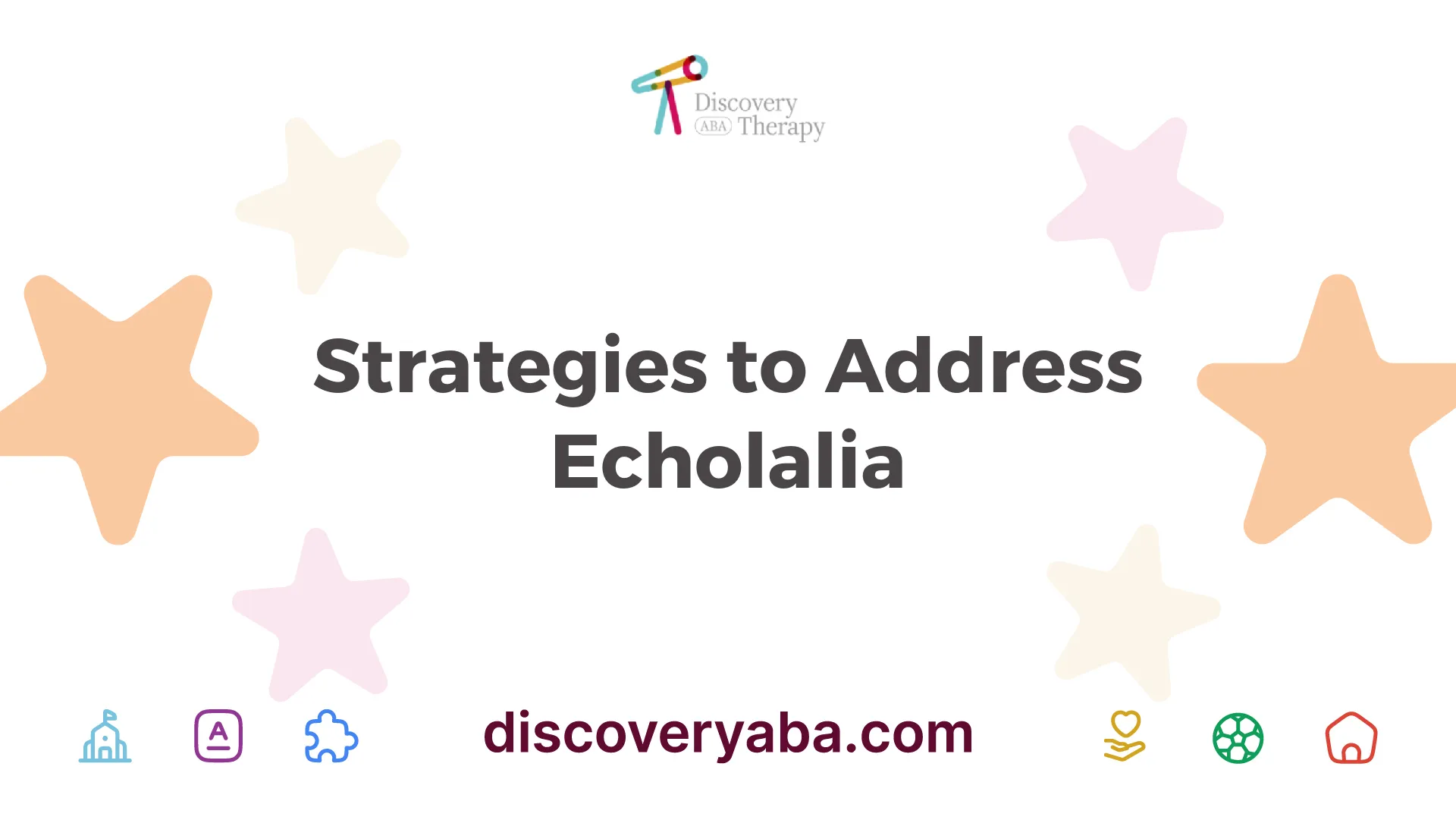Addressing Echolalia with ABA
Discover effective strategies for addressing echolalia with ABA and support your child’s communication growth.

Understanding Echolalia in Autism
Understanding echolalia is crucial for parents and caregivers of individuals with Autism Spectrum Disorder (ASD). This section provides a definition of echolalia and its prevalence within the autistic community.

Definition and Types of Echolalia
Echolalia refers to the repetition of phrases or sentences, often heard from others, and is frequently seen in individuals on the autism spectrum. There are two main types of echolalia:
Echolalia can serve various functions, such as coping with sensory overload or assisting in communication when an individual struggles to form their own sentences.
Prevalence of Echolalia in Autism
Approximately 75% of children with Autism Spectrum Disorder exhibit some form of echolalia. Echolalia can sometimes be viewed as an adaptive response to challenges in language acquisition and communication. Interestingly, echolalia can indicate positive outcomes for future language development, suggesting that the ability to repeat phrases may be a stepping stone towards creating original speech.
It is important to note that while echolalia is common, it can signal developmental differences if it continues beyond the toddler years, particularly alongside delayed speech development. When addressing echolalia within the context of autism, early intervention and the right therapeutic strategies can play a critical role in enhancing communication skills.
For more insights and strategies for managing echolalia, caregivers can explore additional resources on reducing anxiety through ABA and aba for daily routines in autism.

Strategies to Address Echolalia
Addressing echolalia in individuals with autism can involve a variety of techniques and collaborations. This section highlights effective reduction techniques and the significant role of speech-language pathologists in this process.
Reduction Techniques for Echolalia
Several strategies can be employed to reduce echolalia and encourage more functional communication. The following methods have been identified as effective:
TechniqueDescriptionUsing Simple Words and PhrasesSimplifies the language to promote clarity in communication.Prompting Correct ResponsesProvides scripts or examples for appropriate communication.Utilizing Visual SupportsIncorporates images or symbols to aid understanding and expression.Avoiding Leading QuestionsRefrains from questions that prime for repetition.Offering ChoicesPresents options instead of open-ended questions to reduce repetitive responses.Modeling CommunicationDemonstrates interactions with a partner to illustrate desired responses.Refraining from Name UseAvoids saying the child’s name to prevent prompting repetition.Practicing PatienceEncourages waiting for responses to foster communication development.
Utilizing these techniques allows caregivers and educators to create a supportive environment conducive to the development of functional language. Further techniques can be explored in relation to aba therapy for daily routines in autism or addressing managing transitions, which may also involve echolalia strategies.
Role of Speech-Language Pathologists
Speech-language pathologists (SLPs) play a vital role in addressing echolalia through tailored interventions. They employ a range of strategies designed to encourage meaningful communication and reduce reliance on echolalic speech. Some effective techniques used by SLPs include:
Through these interventions, SLPs facilitate a deeper understanding of communication, promoting overall development in children with autism. For parents and caregivers, collaborating with a speech-language pathologist can provide structured support tailored to the individual's needs, enhancing their capacity to engage in more effective communication.
For further insights into strategies for addressing specific behaviors associated with autism, consider exploring aba therapy for emotional growth or reducing anxiety through aba.
Intervention Approaches
Addressing echolalia with ABA therapy involves structured strategies designed to improve communication and social skills in individuals with autism. Two significant intervention approaches include Applied Behavior Analysis (ABA) therapy and a multidisciplinary team approach.
Applied Behavior Analysis (ABA) Therapy
Applied Behavior Analysis (ABA) therapy is commonly used to support individuals with autism. Research indicates that 64% of individuals with autism benefit from ABA, particularly in enhancing communication skills, social interactions, and managing behavioral challenges. The growing demand for certified ABA therapists underscores its effectiveness, with a staggering 5,852% increase in demand for professionals trained in this field from 2010 to 2021 [4].
ABA therapy employs various techniques to address echolalia, focusing on teaching functional communication and gradually reducing reliance on echoing phrases. This can include strategies such as:
For parents and caregivers, understanding how ABA therapy for managing transitions can help prepare individuals for changes in routines is essential.
Key TechniquesDescriptionCues-Pause-PointEncourages responding to cues after a delay.Script TrainingTeaches specific language for social interactions.Visual CuesSupports comprehension through visual aids.
Multidisciplinary Team Approach
In treating echolalia, a multidisciplinary team approach is vital. Such a team typically includes parents, neurodevelopmental specialists, therapists, psychologists, and special educators [5]. This collaborative effort ensures that the individual's unique needs are met through varied expertise.
Each team member plays a specific role:
This comprehensive approach enhances the effectiveness of interventions, leading to improved outcomes for individuals with autism. By ensuring cohesive communication within the team, care strategies are more likely to be consistent and supportive.
Utilizing both ABA therapy and a multidisciplinary framework not only addresses echolalia effectively but also fosters overall development and emotional growth. Implementing these approaches is crucial in providing targeted resources and support to boost communication skills and social interaction in individuals with autism. For further details on specific applications of ABA, explore our article on aba therapy for emotional growth.
Importance of Early Intervention
Early intervention is critical for children with autism, particularly those displaying echolalia. Prompt and effective support can significantly enhance their development and improve their overall quality of life.
Benefits of Early Detection
Timely identification of autism and its related challenges can lead to numerous benefits. Research indicates that early intervention can improve communication skills, social engagement, and adaptive functioning. Interventions can also reduce the persistence of echolalia, which is a common challenge faced by many autistic individuals.
BenefitDescriptionEnhanced CommunicationChildren who receive early support may develop functional language skills more effectively. Approximately 25-30% of autistic individuals are minimally verbal [6].Improved Social SkillsEarly detection allows for targeting social skills, leading to better peer interactions. Programs focused on improving peer interactions with aba are particularly beneficial.Increased IndependenceEarly support fosters independence, equipping children with the tools they need for daily living skills. Techniques such as building independence with aba can be integrated.
Impact on Long-Term Development
The long-term benefits of early intervention are profound. Children who receive appropriate therapies by age 3 are more likely to experience positive outcomes in various areas of their lives. Intensive early interventions, such as applied behavior analysis (ABA), can diminish the impact of echolalia and lead to improved functionality as the child matures.
Long-Term OutcomeDescriptionAcademic SuccessChildren with early interventions show higher rates of academic achievement and are better prepared for school transitions.Improved Emotional Well-beingInterventions can also promote emotional growth and regulate behaviors [8].Adaptive FunctioningEnhanced daily living skills lead to more autonomy, contributing to a higher quality of life. Techniques, such as aba for daily routines in autism, enable smoother everyday experiences.
Early intervention plays an essential role in shaping the future of children with autism. Taking prompt action not only addresses issues like echolalia but also contributes to their overall development. Most importantly, the impact of these interventions resonates throughout their lives, influencing communication, social integration, and independence.
Collaborative Care
In addressing echolalia using ABA therapy, collaborative care is crucial for ensuring effective support for individuals with autism. This approach involves teamwork among various professionals, emphasizing the importance of effective communication and ethical practices.
Interprofessional Collaboration
Interprofessional collaboration among specialists is essential for delivering high-quality care and optimizing patient outcomes. The American Speech-Language-Hearing Association (ASHA) underscores the importance of working collaboratively with members of different professions to enhance care delivery. Among these professionals, Speech-Language Pathologists (SLPs) and Behavior Analysts (BAs) play key roles in addressing echolalia.
Collaboration can be fostered through effective communication, mutual respect, and understanding of each professional's responsibilities. Utilizing Interprofessional Collaborative Practice (IPP) principles is beneficial, which include:
By adhering to these principles, interprofessional collaboration can lead to improved communication, teamwork, and ultimately better outcomes for the individual served.
Ethical Considerations in Therapy
Ethical considerations are paramount when providing therapy to individuals with autism. Practitioners must adhere to guidelines established by professional organizations such as ASHA. They emphasize the duty of Speech-Language Pathologists to maintain the welfare of those they serve by employing evidence-based clinical judgment [10].
Concerns arise regarding certain practices within the field of Applied Behavior Analysis, particularly the use of aversive techniques. The refusal of certain organizations, like the Association for Behavioral Analysis International, to denounce these methods has led to criticism, especially given that the United Nations labeled practices such as painful shock therapy as torture in 2019.
Navigating ethical dilemmas requires practitioners to advocate for client welfare, utilize effective communication, and foster a client-centered approach in all practices. Adhering to ethical standards is vital in ensuring that interventions are respectful, humane, and beneficial for individuals with autism, particularly when addressing echolalia with ABA therapy.
Research and Strategies
Current Interventions for Echolalia
Addressing echolalia in children on the autism spectrum involves various strategies aimed at promoting effective communication. Some current interventions include:
Additionally, speech-language pathologists play a vital role in the intervention process, employing techniques such as cues-pause-point training, script training, and visual cues. Echolalia can be a normal developmental phase; however, if it continues beyond the toddler years, especially with delayed speech, it may indicate autism [3].
A comprehensive approach may also include alternative communication methods. Structured training techniques, such as the Picture Exchange Communication System (PECS) and American Sign Language (ASL), facilitate purposeful communication, offering children alternatives beyond verbal speech. Moreover, studies suggest teaching responses like “I don’t know” after ambiguous utterances can enhance functional communication in children displaying immediate echolalia.
Evidence-Based Practices for Treatment
Recent research highlights the complexity of echolalia and reinforces the necessity of evidence-based practices. A significant study indicated a relationship between demand complexity and immediate echolalia among students with autism in academic settings. Results revealed that echolalia was more common during intricate tasks, indicating it may be influenced by social contexts.
The growing prevalence of autism, which rose from approximately 0.25% (1994-1999) to about 0.99% (2015-2019) [2].
Understanding these practices and strategies helps parents and caregivers address echolalia effectively within the context of autism treatment, ultimately fostering better communication and developmental outcomes for individuals on the spectrum. For additional resources on specific ABA techniques, consider exploring aba therapy for attention issues or aba for managing transitions.
References
[2]:
[3]:
[4]:
[5]:
[6]:
[7]:
[8]:
[9]:
[10]:
[11]:
[12]:
Does Your Child Have An Autism Diagnosis?
Learn More About How ABA Therapy Can Help
Find More Articles
Contact us
North Carolina, Nevada, Utah, Virginia
New Hampshire, Maine
Arizona, Colorado, Georgia, New Mexico, Oklahoma, Texas
.avif)




































































































